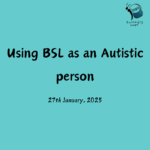From the inside, meltdowns can be terrifying. Some people experience it as watching what is happening around them, the destruction that they are causing, without any ability to make it stop.
The biggest tip for supporters dealing with meltdowns is learning to stay calm. It can be distressing to watch as a bystander, but a supporter being able to put their own feelings aside and focusing on the needs of the individual in the situation is very important.
One of the first steps to take would be to change to a low stimulus environment. How to do that, and what that might look like would vary in different situations, but in the home, it would be a good idea to make sure there is a quiet room where meltdowns can be safely dealt with. When out and about, having a plan for how to handle a potential meltdown is also a good idea. Do some research, a lot of places have sensory rooms or quiet rooms. Being aware of where these are when something happens can be useful.
It is imperative to keep the person experiencing the meltdown and their supporters safe, and limiting access to dangerous objects is an important step in that process. De-escalation training could be useful for anyone who is likely to ever deal with someone experiencing a meltdown.
Stopping meltdowns before they happen is, of course, preferable. Try to notice the buildup to a meltdown. The buildup can be long, and it is likely not one single thing that triggers the meltdown, but rather a lot of things adding up. Keeping that in mind, trying to look at what could have been done differently once the meltdown has settled down can help prevent them in the future. It is important to remember that thinking about the triggers and the buildup is not done to place blame. The meltdown has happened, whose “fault” it was is irrelevant, but if something can be done to prevent them in the future, that is to everyone’s benefit.
Another thing to think about outside the meltdown itself, is what might be helpful to the individual. Whether you are the person experiencing meltdowns, or one of their supporters have a talk and a think about what would be helpful in the moment. Some people find music, calming words, or white noise helpful. Personally, I need everyone to be quiet and make it as low stimulation as possible. Supporters should generally aim to give space, but be available. Fidget toys; weighted blankets; sensory tools, such as bubble tubes; cosy hiding spaces and soft things, such as teddy bears, can all be helpful in this period of time or in recovery. When they might be useful, and what specifically is useful to each individual will vary, so some trial and error is to be expected.
After a meltdown, rest is needed. The experience is draining, and I often feel like I have run a marathon after one. I will usually have a few hour nap, and it will take a few days, sometimes weeks to fully recover.
Once a meltdown happens it generally has to run its course. Being prepared for them, working to limit them, and working to handle them in a way that suits the individual, should help make them more manageable both for the supporters and for the person experiencing the meltdown.
